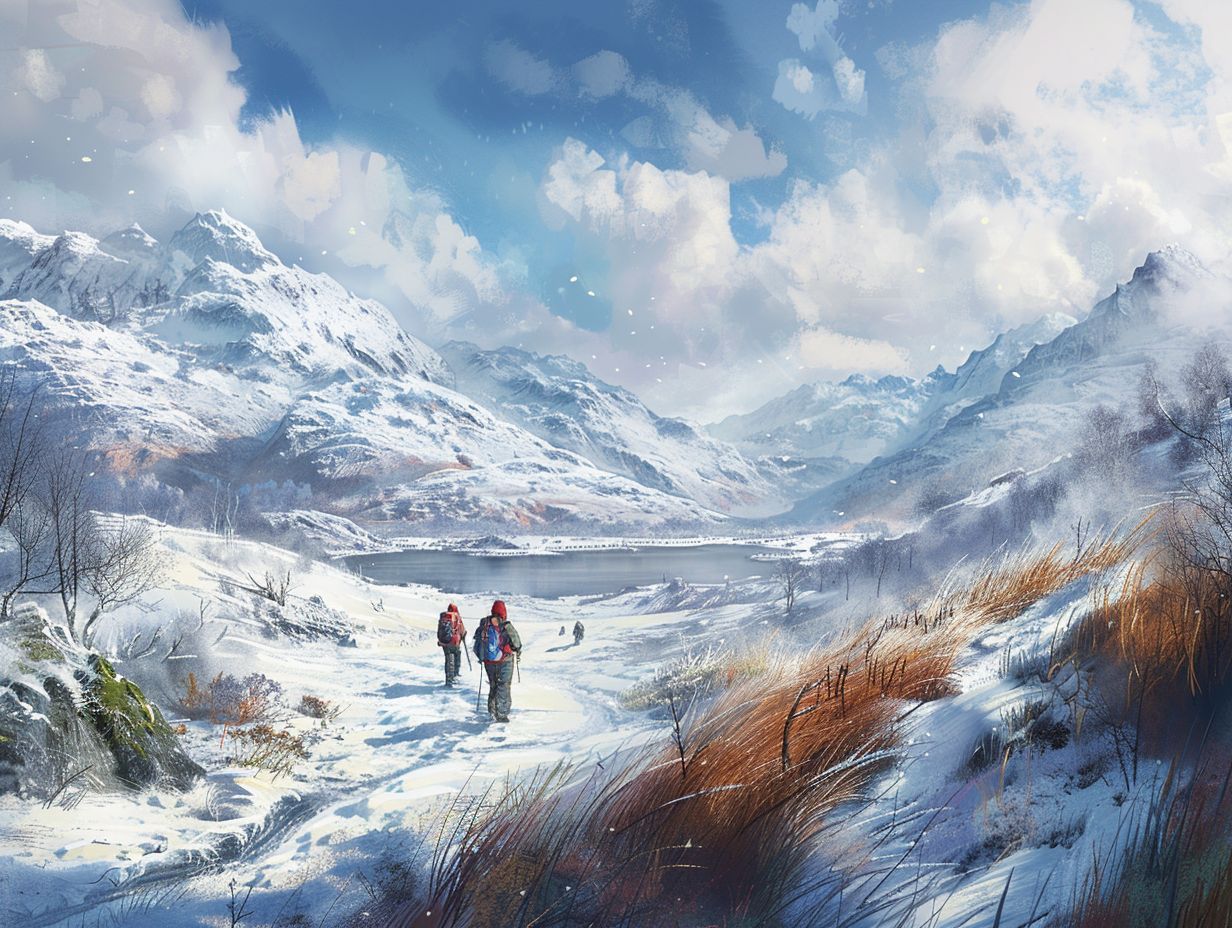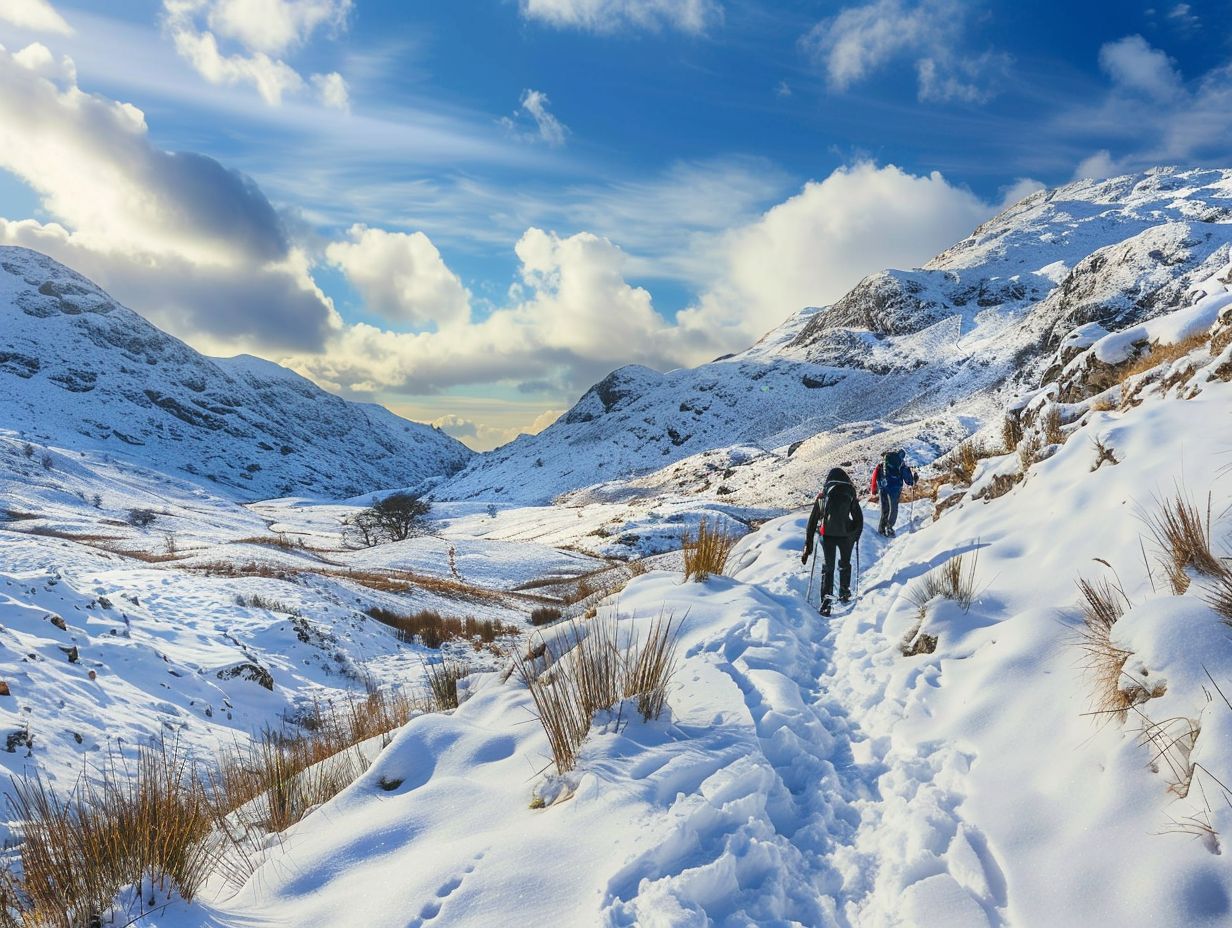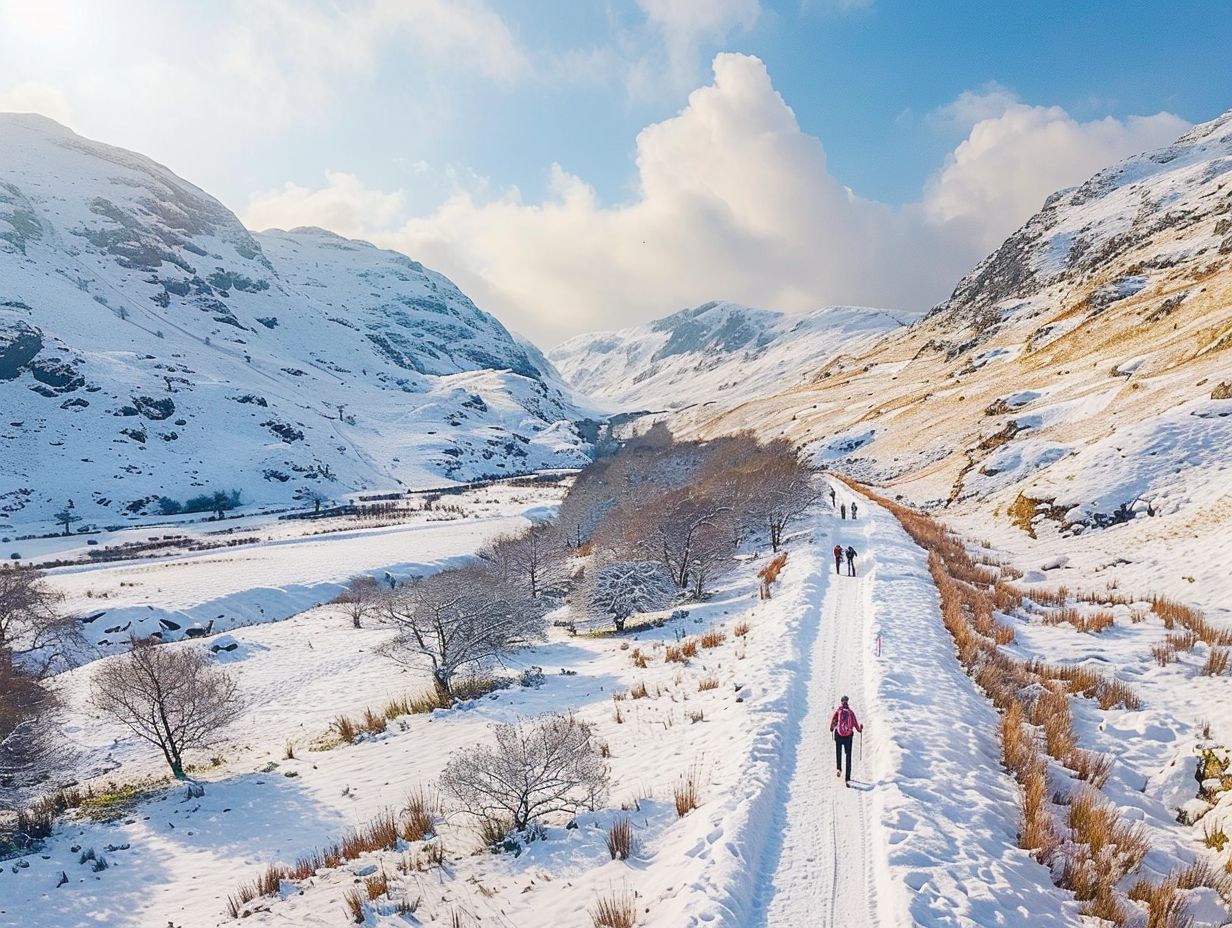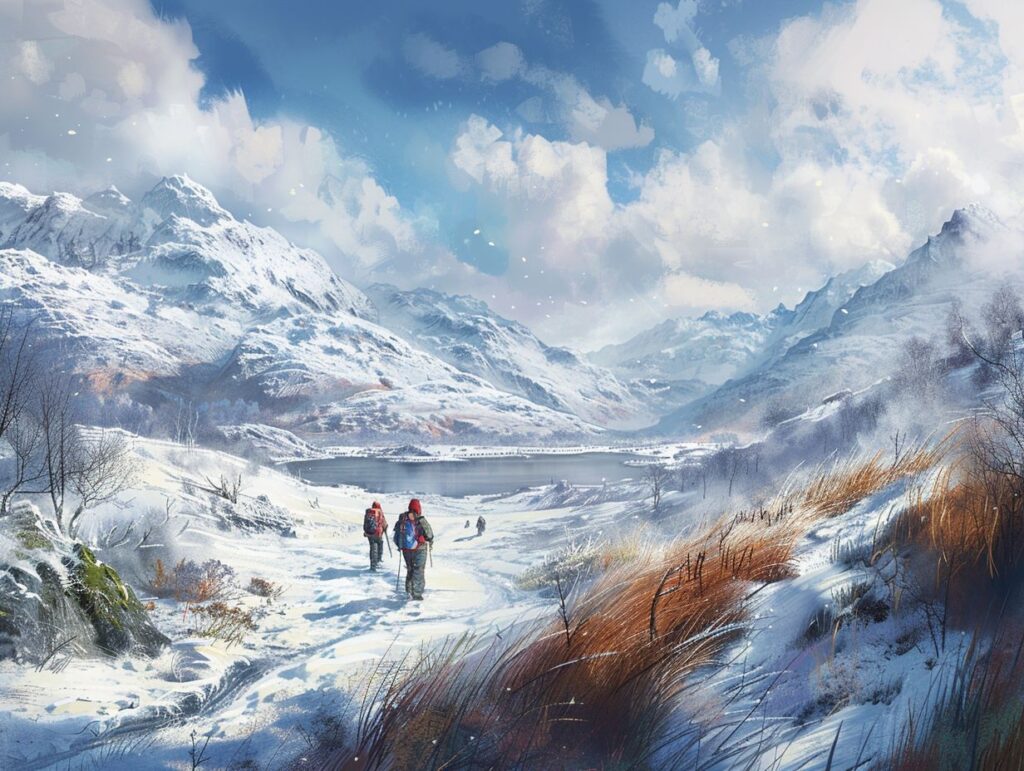Winter hiking in the UK offers a unique and exhilarating experience. From avoiding the crowds to challenging yourself in a different landscape, there are plenty of reasons to hit the trails during the colder months.
Before you lace up your boots, it’s important to consider the proper gear, weather conditions, and trail difficulty.
Discover the top UK hikes for snowy landscapes and find essential tips for a safe and enjoyable winter adventure.
Key Takeaways:

- Winter hikes in the UK offer a unique and less crowded experience compared to other seasons.
- Adequate preparation, such as proper gear and knowledge of weather conditions, is crucial when hiking in the winter.
- Some of the best snowy landscapes in the UK can be found on hikes such as Ben Nevis, Snowdon, and Helvellyn.
Top UK Hikes for Snowy Landscapes
The United Kingdom presents a diverse selection of striking winter hiking routes, where snow-covered terrains metamorphose customary paths into awe-inspiring winter wonderlands, ideal for individuals in pursuit of adventure and picturesque charm.
1. Ben Nevis, Scotland
Ben Nevis, situated in the Scottish Highlands, presents a challenging winter trek that culminates in reaching the highest summit in the United Kingdom amidst a picturesque snowy landscape.
As one ascends the steep snow-clad slopes, each step taken evokes a profound sense of achievement and wonder at the rugged magnificence that surrounds. The icy winds introduce an element of unpredictability to the journey, serving as a poignant reminder of nature’s formidable power.
Despite the biting cold, the panoramic views from the peak are undeniably awe-inspiring, with expansive snow-covered peaks stretching as far as the eye can see. Standing on top of Ben Nevis during winter goes beyond mere mountaineering skill, providing a transformative experience that instils humility in the face of such majestic beauty.
2. Snowdon, Wales
Snowdon in Wales undergoes a picturesque transformation into a snowy peak during the winter season, presenting a selection of routes that accommodate varying skill levels. Embarking on a winter hike on Snowdon provides a distinctive experience that highlights the unspoilt beauty of nature.
The available routes offer a range of difficulty levels, from gentle paths suitable for novice hikers to more challenging trails designed for experienced individuals. While navigating through the snow-covered terrain, hikers can anticipate awe-inspiring vistas of the encompassing valleys and peaks draped in a tranquil white blanket.
The winter landscape contributes a magical essence to the hike, culminating in an unforgettable adventure for those willing to endure the cold temperatures in order to explore this magnificent mountain.
3. Helvellyn, Lake District

Helvellyn, located in the Lake District, is widely acclaimed for its picturesque winter trails that lead to a summit offering panoramic views of the snow-covered landscape.
Exploration of Helvellyn during the winter season not only affords the opportunity to behold the ethereal beauty of the snowy environs but also poses a challenge to hikers due to the swiftly changing and unpredictable weather conditions.
Enthusiasts seeking adventure are naturally attracted to the popular Striding Edge and Swirral Edge routes, renowned for their exhilarating ridge walks and stunning vistas.
As hikers progress towards the summit, they are greeted with awe-inspiring panoramic views from the peak of Helvellyn, illustrating the expansive beauty of the Lake District National Park adorned in a pristine white cloak.
4. Scafell Pike, Lake District
Scafell Pike, the highest peak in England, provides an invigorating winter hiking opportunity with trails that offer a sense of adventure amidst the snow-covered landscape.
Exploration of the frosty paths leading to the summit of Scafell Pike represents a genuine test of endurance and proficiency.
The diverse trails, including the Corridor Route or the more demanding Lord’s Rake, present a combination of breathtaking vistas and challenging terrain. Navigating through the snow-laden rocks and steep inclines necessitates meticulous planning and appropriate equipment.
The sense of achievement upon reaching the summit, with the snow-capped mountains extending before you, is unparalleled. The winter hike at Scafell Pike seamlessly merges the excitement of adventure with the serenity of the snow-clad wilderness, rendering it an indelible and unparalleled experience.
5. Kinder Scout, Peak District
Kinder Scout in the Peak District offers an engaging winter hiking experience characterized by snowy trails and a rugged landscape, establishing itself as a preferred destination among winter hiking enthusiasts.
The appeal of exploring the winter charm of Kinder Scout extends beyond its demanding topography, encompassing the opportunity to behold captivating snow-covered panoramas that exude enchantment.
Winter hiking enthusiasts can anticipate an environment of tranquility and serenity, with the sound of freshly fallen snow crunching beneath their boots serving as a captivating backdrop to their excursion.
The hushed ambiance and seclusion of the snow-laden trails offer a singular sense of adventure and an occasion to establish a profound connection with nature in an exceptionally enchanting setting.
Tips for Hiking in the Snow
Engaging in snow hiking necessitates meticulous preparation and deliberate strategies to ensure both safety and enjoyment. This includes donning appropriate gear and maintaining vigilance regarding prevailing weather conditions.
1. Bring Extra Layers
It is essential to bring additional layers for winter hikes, as temperatures have the potential to decrease unexpectedly, and having extra clothing aids in retaining warmth.
Properly layering clothing is crucial for ensuring comfort and safety during winter treks. A successful layering system comprises three primary types: base layers, insulation layers, and outer shell layers.
Base layers efficiently wick moisture away from the skin, insulation layers offer warmth, and outer shell layers provide protection against wind and water. Maintaining body temperature equilibrium by adjusting layers as needed is crucial for averting overheating or excessive coldness.
Additionally, it is advisable to utilise breathable fabrics to prevent perspiration, which can result in increased chilliness later on.
2. Stay Hydrated
Maintaining hydration is equally crucial during winter excursions as it is in warmer climates, notwithstanding the cold weather conditions.
The lower temperatures characteristic of winter can heighten the risk of dehydration, as the body continues to lose moisture through respiration and perspiration, even if thirst sensations are diminished. Symptoms indicative of dehydration include dark-coloured urine, dryness of the oral cavity, sensations of lightheadedness, and weariness.
To ensure adequate hydration levels, it is advisable to consume water in small, regular quantities rather than in large volumes.
Employing insulated water receptacles or hydration systems can prevent water from freezing in sub-zero conditions; simultaneously, the use of insulated tube covers for hydration systems can facilitate the continuous flow of water during winter trekking endeavours.
3. Take Breaks and Watch for Signs of Hypothermia

It is imperative to incorporate regular breaks and remain vigilant for indications of hypothermia as fundamental safety measures during winter hikes. Early symptoms of hypothermia, such as shivering, numbness, confusion, slurred speech, and clumsiness, need to be promptly identified to avert severe consequences.
Taking breaks to warm up by seeking shelter, changing into dry clothing, and consuming warm beverages can effectively help preserve body heat.
Emphasising prevention through proper attire with layered clothing, maintaining dryness, and ensuring adequate nutrition and hydration is crucial for individuals embarking on winter excursions.
Understanding how to respond to hypothermia by implementing gradual rewarming techniques, insulation methods, and seeking medical assistance when necessary can be instrumental in saving lives in cold outdoor environments.
4. Use Traction Devices
Utilising traction devices such as crampons or microspikes can markedly enhance safety and stability when traversing icy or snowy trails during winter excursions.
Crampons are purposefully crafted with steel spikes that offer exceptional traction on icy surfaces, rendering them well-suited for more demanding terrains necessitating heightened grip.
Conversely, microspikes are equipped with smaller spikes that are adaptable and appropriate for a broader spectrum of winter environments.
The selection of the appropriate traction device should be contingent upon the complexity of the hiking route and the prevailing terrain conditions. When employing these devices, it is imperative to ensure a proper and secure fit to the boots to forestall slippage. Regular inspection for signs of deterioration is advised to uphold their efficacy.
Frequently Asked Questions
1. What are the best UK hikes for experiencing snowy landscapes?
Some of the best UK hikes for experiencing snowy landscapes include Helvellyn in the Lake District, Ben Nevis in Scotland, and Snowdon in Wales. Other popular options include the Cairngorms National Park and the Yorkshire Dales.
2. When is the best time to go on these hikes?
The best time to go on these hikes is usually during the winter months, from December to February. This is when the weather is most likely to be snowy and the landscapes will be at their most beautiful.
3. Are these hikes suitable for beginners?
Some of these hikes, such as Snowdon and the Yorkshire Dales, can be suitable for beginners as they have well-defined paths and are not too strenuous. However, others like Helvellyn and Ben Nevis require more experience and should only be attempted by experienced hikers.
4. What should I bring on these hikes?
It is important to be well-prepared for these hikes as the weather can be unpredictable. Make sure to bring warm and waterproof clothing, sturdy hiking boots, a map, and enough food and water. It is also advisable to bring a first aid kit and a fully charged phone.
5. Can I camp during these hikes?
Yes, you can camp during these hikes, but make sure to check the local regulations and guidelines before doing so. You will need to bring your own camping equipment and make sure to leave no trace behind.
6. Are there any guided tours available for these hikes?
Yes, there are guided tours available for these hikes. Many tour companies offer guided hikes to these snowy landscapes, providing a safe and informative experience for hikers of all levels. It is also a great way to learn more about the history and culture of the area.

